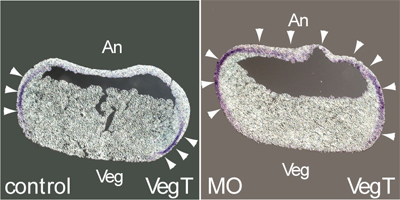| RIKEN Center for Developmental Biology (CDB) 2-2-3 Minatojima minamimachi, Chuo-ku, Kobe 650-0047, Japan |
May 30, 2008 – The development of the embryo is a tale of either/or gateways and roads not taken; decisions made at an early stage in development can put constraints on all those made subsequently. The same is often true of the induction of differentiation of pluripotent cells in culture, which requires step-by-step instructions to guide cells to adopt a terminally differentiated fate. For this reason, the identification of those early signals that steer undifferentiated cells toward a specific germ layer is of fundamental interest to scientists working both in vivo and in vitro. The African clawed frog, Xenopus laevis, provides an excellent model for studying questions of early vertebrate development through analyses of a pluripotent region of the nascent embryo known as the animal cap, which is the site of in vivo germ layer specification and is amenable to tissue culture as well. That notwithstanding, there have been no reports of a zygotic factor able to regulate one of the earliest lineage decisions during gastrulation, the choice between ectodermal and mesodermal fates.
Now, Noriaki Sasai and colleagues in the Laboratory for Organogenesis and Neurogenesis (Yoshiki Sasai; Group Director) have identified a novel ectodermal factor that prevents mesodermal differentiation in both Xenopus animal cap and mouse embryonic stem cells in a report published in Cell. This factor acts by an unsuspected molecular mechanism, the inhibition of p53, a gene best known for its role in genomic remodeling and cancer. Having observed that mRNAs from stage 11.5 animal caps (about a half-day into development) suppressed mesodermal differentiation, the group screened a library of cDNAs to try to pinpoint this inhibitory function. “There were already a number of reports of maternal lineage determinants,” says Sasai, “but the fact that these were residual proteins that had been expressed in the egg, rather than newly in the embryo, made it unlikely that they could account for fate specification during gastrulation.” On completing the screen, five molecules showed mesoderm-inhibiting activity, and as four were already relatively well-characterized, they narrowed their focus to the fifth, a gene encoding zinc-finger protein known as XFDL156. Sasai first tried overexpression experiments in animal caps that had been induced toward the mesodermal lineage, and found that XFDL suppressed mesodermal, but not neural or endodermal, markers. The converse experiment, in which XFDL function was blocked by antisense morpholinos, resulted in mesodermal expansion, suggesting that this factor suppresses mesodermal differentiation in the ectoderm. The question was, how? As recent studies have shown a role for the transcription factor p53 in mesodermal differentiation, Sasai looked for a possible functional relationship between these two proteins in animal cap assays. After confirming by a double knockdown that its function was dependent on p53, he next tested the effect of XFDL on p53 (and its co-factor p300) and determined that it effectively inhibited p53’s ability both to activate the mesoderm marker gene, Mix.2 and to promote apoptosis in the animal cap. Immunoprecipitation showed that XFDL and p53 co-precipitated, indicating a direct interaction between the two. Further analyses, by gel shift assay and chromatin immunoprecipitation, revealed that XFDL-bound p53 fails to bind to its target genes. Investigating the structural underpinnings of this interaction, Sasai et al. next made a number of p53 constructs engineered to lack various protein domains, allowing them to identify a regulatory domain in the carboxyl-terminal region as the sequence necessary for XFDL binding. Interestingly, a search in other genomes for related genes turned up a pair of zinc-finger protein encoding genes in the mouse that shared the ability to inhibit mesodermal differentiation and to interfere with p53, suggesting that mammalian ES cells may use a mechanism for ectodermal differentiation similar to that in the frog. “With these findings. I think we have managed to add a piece that has long been missing from the puzzle of early development from undifferentiated, pluripotent cells,” says Group Director Yoshiki Sasai. “We’re hopeful that this will take us one step closer to the day when we will be able to control every major step in the process of differentiation from ES cell to neuron.”
|
|||||
|
|||||
|
| Copyright (C) CENTER FOR DEVELOPMENTAL BIOLOGY All rights reserved. |

